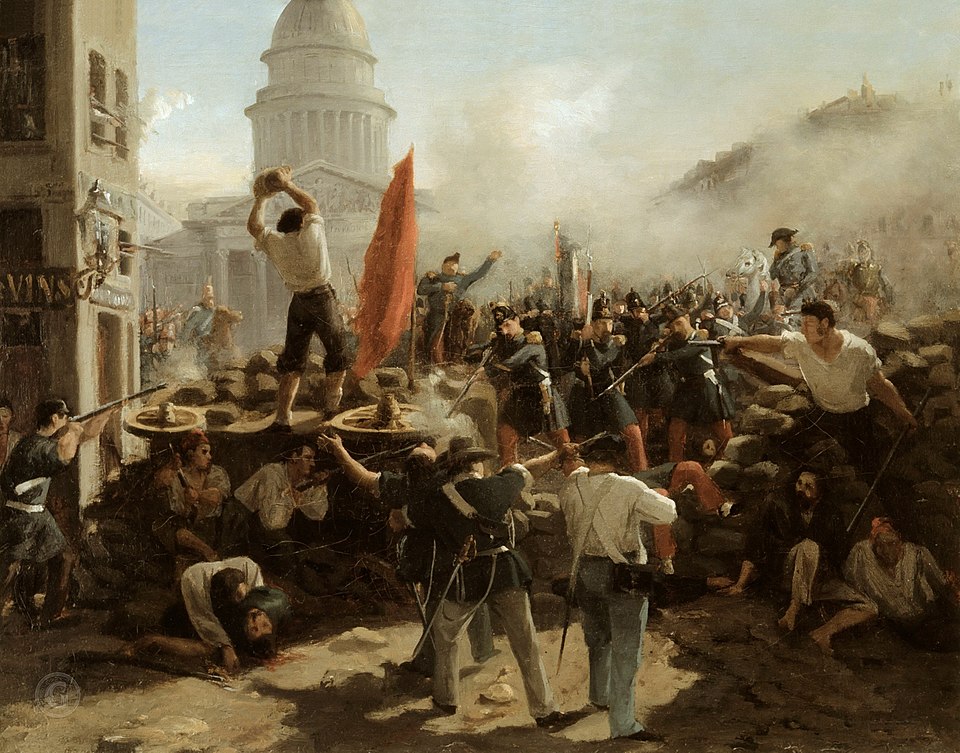
Why were there so many revolutions in 1848? There are a number of factors why there were so many revolutions in 1848, from economics to climate.
Starting in 1848 and going through to 1849, there were revolutions in over 50 different countries and principalities. These were mostly in Europe, but countries in South America were also affected. The countries that had revolutions, or uprisings, were Italy, France, Germany, Denmark, Austria, Hungary, Galicia (roughly where Ukraine is now), Sweden, Switzerland, Poland, Romania, Belgium, Ireland, Norway, New Granada (modern day Colombia and Panama), Colombia, Chile, Brazil, Mexico, and many other places. The revolutions were not necessarily connected, but word of one revolution or uprising spread and gave confidence to people in another region. A similar thing happened with the Arab Springs revolutions in the 2010s. Some of these were just uprisings that were put down by the government or faded away on their own. Some of them were much larger revolutions that led to complete regime change. So, what caused them?
Like any historical event, there wasn’t only one cause. Rather, it was a building up of different causes and 1848 just happened to be the year where everything came to a head. The first problem was the rising level of industrialization in European countries. Since the beginning of the 19th century, technology had improved in leaps and bounds and more and more things were being automated. This led to job loss and loser salaries. People had moved from the rural areas in search of jobs, but that just brought overcrowding and enormous numbers of people were being crammed into unsuitable housing. They were small and unsanitary. There were often outbreaks of cholera and other diseases. If people complained about their working conditions, there were far more people wanting jobs than there were jobs, so wages constantly fell. Many of the people who had work were working for 12 to 15 hours a day with only Sunday mornings off to go to church.
The second cause was witnessing the successes of other revolutions. The first of the series of revolutions appears to have been the February Revolution in France. The people rose up against the government and King Louis Philippe. The king was forced to abdicate and the Second French Republic was proclaimed. This was a revolution that worked and had the desired outcome. Oppressed people in other countries saw this and thought that if it had worked in France, it should work in their country as well. Sometimes it did work, but more often than not, it didn’t.
Another cause was simple hunger. Since the end of the 1830s, there had been a succession of bad harvests. Food was short and prices were high. There was a particularly bad harvest in 1846. People could not afford to feed themselves. When people are living in terrible conditions and they can’t afford to eat, revolution can never be far away.
Technology also helped spur the discontent with the printing presses. Paper had become cheap and printing presses were fast. It was very easy to make cheap newspapers that would spread the awareness of everything going on around the various countries.
One of the biggest causes of unrest was the monarchies and the aristocracies that controlled all of these regions. While the people were working all of the hours they had and barely having enough to eat, the monarchy were getting richer and living lavish lifestyles. The people had no power, no representation, and nothing they could do to politically bring about change. The only choice they had was armed revolution. The people wanted a voice, they wanted change, they wanted fairness.
The revolutions brought about change in a number of countries, but not all. The French monarchy was overthrown and a republic proclaimed. The revolution in Denmark changed the monarchy from an absolute monarchy to a constitutional monarchy. The revolutions in Italy started it along the road that would end in the country’s unification. The same thing happened in Germany. Hungary tried to get independence from Austria. It wasn’t able to go that far, but the revolution did put an end to serfdom, which was a good thing. Poland tried to get independence from Russia. That wasn’t successful, but the revolutions in Poland, the Balkans, and Romania, did manage to get some reforms. In South America, the revolutions led to a change of government in Colombia. It inspired the Chilean revolution of 1851, and it started a revolt in Brazil.
There were many more revolutions that happened just before or just after 1848, but there were a large number that happened in that year. Towards the end of the first half of the 19th century, people had just had too much of the conditions they were being forced to live in. And this is what I learned today.
Sources
https://en.wikipedia.org/wiki/Revolutions_of_1848
https://www.studentsofhistory.com/the-revolutions-of-1848
https://thinkigcse.net/history/page/55283/2-why-were-there-so-many-revolutions-in-1848
https://www.britannica.com/summary/Europe
https://en.wikipedia.org/wiki/French_Revolution_of_1848
https://en.wikipedia.org/wiki/Unification_of_Italy
By Horace Vernet – memo.fr and gallerix.org, Public Domain, https://commons.wikimedia.org/w/index.php?curid=71217
